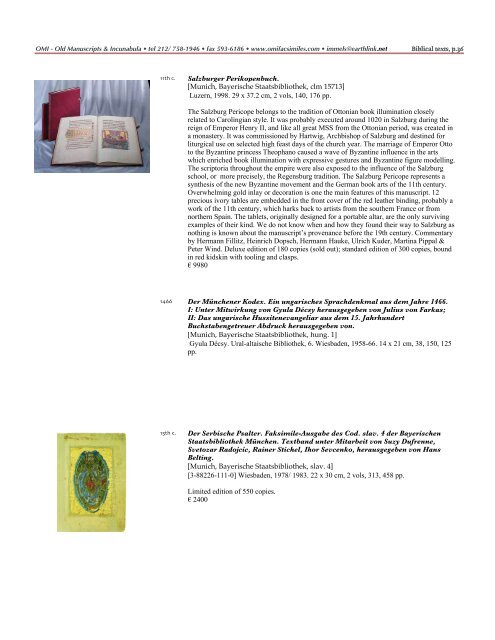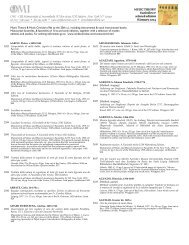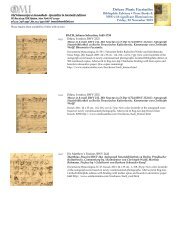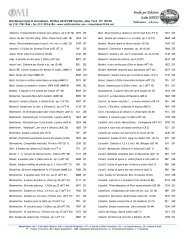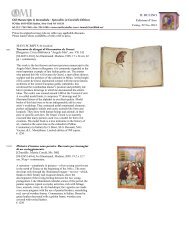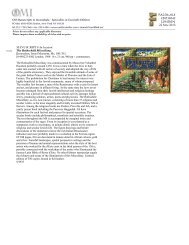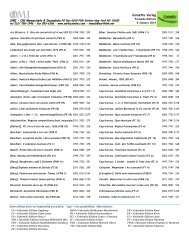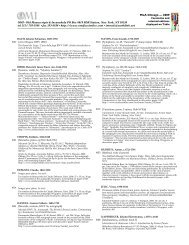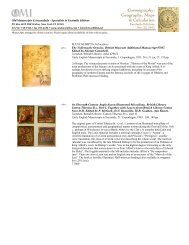Bibles & sacred texts - facsimiles - Omi
Bibles & sacred texts - facsimiles - Omi
Bibles & sacred texts - facsimiles - Omi
Create successful ePaper yourself
Turn your PDF publications into a flip-book with our unique Google optimized e-Paper software.
OMI - Old Manuscripts & Incunabula • tel 212/ 758-1946 • fax 593-6186 • www.omi<strong>facsimiles</strong>.com • immels@earthlink.net Biblical <strong>texts</strong>, p.36<br />
11th c. Salzburger Perikopenbuch.<br />
[Munich, Bayerische Staatsbibliothek, clm 15713]<br />
Luzern, 1998. 29 x 37.2 cm, 2 vols, 140, 176 pp.<br />
The Salzburg Pericope belongs to the tradition of Ottonian book illumination closely<br />
related to Carolingian style. It was probably executed around 1020 in Salzburg during the<br />
reign of Emperor Henry II, and like all great MSS from the Ottonian period, was created in<br />
a monastery. It was commissioned by Hartwig, Archbishop of Salzburg and destined for<br />
liturgical use on selected high feast days of the church year. The marriage of Emperor Otto<br />
to the Byzantine princess Theophano caused a wave of Byzantine influence in the arts<br />
which enriched book illumination with expressive gestures and Byzantine figure modelling.<br />
The scriptoria throughout the empire were also exposed to the influence of the Salzburg<br />
school, or more precisely, the Regensburg tradition. The Salzburg Pericope represents a<br />
synthesis of the new Byzantine movement and the German book arts of the 11th century.<br />
Overwhelming gold inlay or decoration is one the main features of this manuscript. 12<br />
precious ivory tables are embedded in the front cover of the red leather binding, probably a<br />
work of the 11th century, which harks back to artists from the southern France or from<br />
northern Spain. The tablets, originally designed for a portable altar, are the only surviving<br />
examples of their kind. We do not know when and how they found their way to Salzburg as<br />
nothing is known about the manuscript’s provenance before the 19th century. Commentary<br />
by Hermann Fillitz, Heinrich Dopsch, Hermann Hauke, Ulrich Kuder, Martina Pippal &<br />
Peter Wind. Deluxe edition of 180 copies (sold out); standard edition of 300 copies, bound<br />
in red kidskin with tooling and clasps.<br />
€ 9980<br />
1466 Der Münchener Kodex. Ein ungarisches Sprachdenkmal aus dem Jahre 1466.<br />
I: Unter Mitwirkung von Gyula Décsy herausgegeben von Julius von Farkas;<br />
II: Das ungarische Hussitenevangeliar aus dem 15. Jahrhundert<br />
Buchstabengetreuer Abdruck herausgegeben von.<br />
[Munich, Bayerische Staatsbibliothek, hung. 1]<br />
Gyula Décsy. Ural-altaische Bibliothek, 6. Wiesbaden, 1958-66. 14 x 21 cm, 38, 150, 125<br />
pp.<br />
15th c. Der Serbische Psalter. Faksimile-Ausgabe des Cod. slav. 4 der Bayerischen<br />
Staatsbibliothek München. Textband unter Mitarbeit von Suzy Dufrenne,<br />
Svetozar Radojcic, Rainer Stichel, Ihor Sevcenko, herausgegeben von Hans<br />
Belting.<br />
[Munich, Bayerische Staatsbibliothek, slav. 4]<br />
[3-88226-111-0] Wiesbaden, 1978/ 1983. 22 x 30 cm, 2 vols, 313, 458 pp.<br />
Limited edition of 550 copies.<br />
€ 2400


